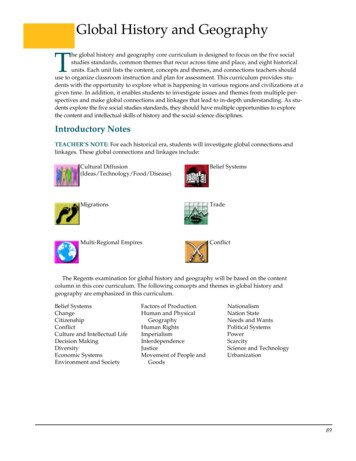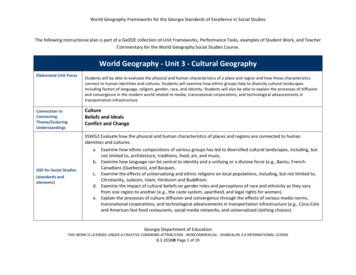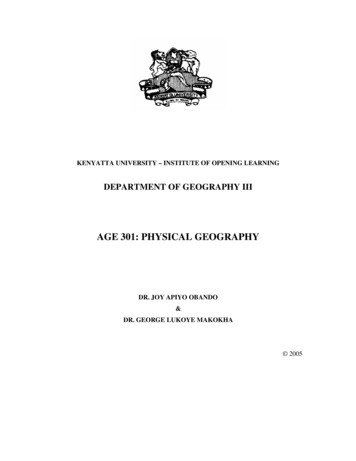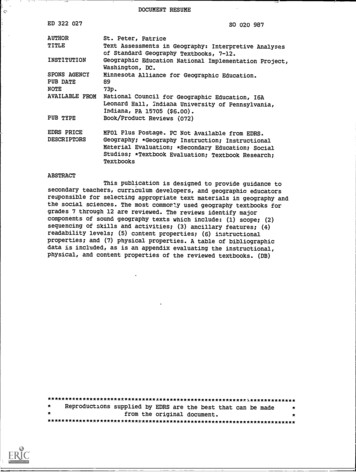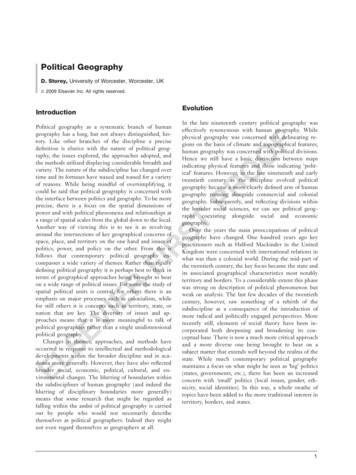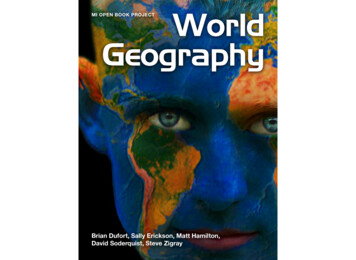
Transcription
MP1-G-WPG-19WORLDPHYSICALGEOGRAPHY Unit-1: Geomorphology" Origin of the Earth" Ocean Bottom Relief" Internal Structure of Earth" Temperature & Salinity of OceanWaters" Formation of Continents &Ocean Basins" Rocks" Forces Affecting the Landforms" Mountain Building" Earthquakes & Tsunamis" VolcanismTOPICS Unit-2: Oceanography" Ocean Currents" Tides" Coral Reefs Unit-3: Climatology" Earth’s Atmosphere" Weather & Climate" Air Mass, Fronts & Cyclones" Plains & Plateaus" Classification of Climatic Regions" Lakes & Swamps" Climate Change Impacts" Weathering & Erosion" Landforms & Their Evolution Unit-4: Bio-Geography" Bio-Geography
ContentsUNIT - 1GEOMORPHOLOGY1.ORIGIN OF THE EARTH .081.2.3.4.5.6.Gaseous Hypothesis (By Immanuel Kant) .8Nebular Hypothesis of Laplace 1976 .9Planetesmial Hypothesis of Chamberlim.9Tidal Hypothesis. 10Supernova Hypothesis (given by Hoyle) . 10Interstellar dust Hypothesis(by Otto Schmidt- Russian Scientist). 117. Big-Bang Theory (expanding universe theory)(by Edwin Hubble) . 112.INTERNAL STRUCTURE OF EARTH .131.2.3.4.5.6.3.Introduction to Geomorphology . 13Scope of Geomorphology . 13Origin of the Earth . 13Sources of Information about the Interior of the Earth . 13Earth’s Interior . 15Earth’s Interior According to Suess . 17FORMATION OF CONTINENTS & OCEAN BASINS .191. The Theory of Continental Drift . 192. Convection Current Hypothesis . 203. Sea - Floor Spreading . 214.ROCKS .291.2.3.4.5.The Rocks Families . 29Igneous Rock . 29Sedimentary Rock . 31Metamorphic Rock . 32FORCES AFFECTING THE LANDFORMS .341. Landforms . 342. Endogenetic Forces (Tectonic Forces) . 34
3. Types of Faults . 374. Work of Exogenetic Forces . 386.MOUNTAIN BUILDING .391. Introduction . 392. Plate Tectonics Theory on Mountain Building . 403. Types of Mountains . 417.EARTHQUAKES & TSUNAMIS .441. How do Earthquakes Form? . 442. Intensity and Magnitude . 463. Earthquake Zones . 474. Tsunami . 488.VOLCANISM .501. Volcanoes and Plate Tectonics Linkage . 502. What Causes a Volcano to Erupt? . 513. Types of Volcanoes . 524. Classification of Volcanoes According to Shape . 529.PLAINS & PLATEAUS .581. Plains . 582. Plateaus . 5910. LAKES & SWAMPS .611. Introduction . 612. Swamps . 633. Economic uses of Lakes and Swamps . 6411. WEATHERING & EROSION .651. Weathering . 652. Factors Affecting Weathering . 673. Mass Movement . 7012. LANDFORMS & THEIR EVOLUTION .731. Running Water . 732. Groundwater . 763. Winds . 784. Waves and Currents . 805. Glaciers . 82GLOSSARY .85
UNIT - 2OCEANOGRAPHY1.2.3.OCEAN BOTTOM RELIEF . 92-971.Continental Shelf . 922.Continental Slope . 943.Continental Rise . 954.Abyssal Plains . 955.Submarine Ridges . 966.Abyssal Hills . 967.Submarine Trenches or Deeps . 968.Submarine Canyons . 969.Bank, Shoal and Reef . 97TEMPERATURE & SALINITY OF OCEAN WATERS . 98-1031.Introduction . 982.Temperature and Density of Ocean Water . 983.Salinity . 100OCEAN CURRENTS . 104-1101.4.TIDES . 111-1141.5.Introduction . 104Causes of Tides . 111CORAL REEFS . 115-1231.Introduction . 1152.Coral Bleaching . 116GLOSSARY .121UNIT - 3CLIMATOLOGY1.EARTH’S ATMOSPHERE . 124-1381.Evolution of Earth’s Atmosphere . 1242.Composition of the Atmosphere . 1253.Structure of the Atmosphere . 1264.Chemical Composition . 127
2.3.4.5.Flow of Gases . 1286.Process of Energy Transfer in the Atmosphere . 1307.Green House Effect & Atmosphere . 1308.Description of Major GHGs . 1339.Mechanism of Controlling Carbon Emission . 136WEATHER & CLIMATE . 139-1611.Factors Affecting Climate . 1392.Pressure . 1483.Winds . 1504.Localised Winds . 1525.The Water Cycle . 1556.Forms of Precipitation . 159AIR MASS, FRONTS & CYCLONES . 162-1741.Fronts and Cyclones . 1642.Thunderstorms . 172CLASSIFICATION OF CLIMATIC REGIONS . 175-1821.5.Koeppen’s, Thornthwaite’s, Trewartha’s Classification . 175CLIMATE CHANGE IMPACTS . 183-1971.Climate and Disaster . 1832.Climate and Agriculture . 190GLOSSARY .194UNIT - 4BIO-GEOGRAPHY1.BIO-GEOGRAPHY. 198-2071.Soil Characteristics . 1982.Factors Responsible for Soil Formation . 1993.Stages of Soil Formation . 2004.Soil Forming Processes . 2015.Soil Profiles and Horizons . 2026.Soil Classification . 2027.Soil Erosion and Conservation . 2058.Social Forestry . 2069.Agro Forestry . 206
UNIT1GEOMORPHOLOGY
WORLD PHYSICAL GEOGRAPHYCHAPTER1ORIGIN OFTHE EARTHGaseous Hypothesis By Immanuel Kant According to this theory primordial matter existed which was of solid state and gas and (0 C) cold. Itwas motion less in the beginning with no kinetic energy. After some time these primordial matter started to collide with each other due to their mutualgravitational attraction, with generated heat and random motion. Due to random motion and more heat, rate of collision increased, increasing rotatory motion, whichchanged their state from solid to gaseous state. With heat increasing size of nebula also increased. It started to spin very rapidly and an irregularring was separated from it, which was later divided into nine-parts. It started spinning too fast thatcentripetal force exceeded centrifugal force. The matter of each ring aggregated at one point to form core which grew as a planet in due course oftime. By repetition of same process rings were separated from newly formed planets and materials separatedfrom them formed satellites. Disadvantages:" Erroneous as he did not explain the source of primordial matter. He assumed their supernaturalexistence." He did not explain the source of external energy due to which particles started to rotate/collide asaccording to Newton’s law, particle remains in rest or motion until and unless an external force isapplied on it. (Absence of external force)" Collision among particles can’t cause rotatory motion among particles." Kant’s assumption that rotatory speed of nebula increased with increase in its size was againstconservation of angular momentum.M Ir2 (Newton’s law of motion) Mwr2wx 1/r2M Mass of the body (Planet)r Radius of the bodyI Inertia of the bodyw Angular speed of the body Significance:" Kant’s hypothesis was the first hypothesis which tried to explain the existence of universe." It paved the way to Laplace’s hypothesis.8www.iasscore.in
WORLD PHYSICAL GEOGRAPHYNebular Hypothesis of Laplace 1796 Nebular hypothesis is totally based on Immanuel Kant theory of gaseous hypothesis, but Laplacecountered the three main backdraws of Kant’s theory with his hypothesis." He assumed that there was a huge and hot gaseous nebula in space from the very beginning." This nebula was rotating (spinning) on its own axis (opposite to existence of scattered solid particle& gas together)." Nebula started to cool down from the very beginning due to radiation of heat from its outer surface.It also started contracting due to cooling (explained conservation of angular momentum)." Due to contraction its angular speed increases and consequently one circular ring separates fromthe core." These rings further condensed to form planets. Backdraws:" He could not explain source of nebula, its heat and its motion." According to nebular hypothesis all satellites should revolve around the sun according to theirfather planet but satellite of Saturn and Jupiter revolve opposite to them." He could not explain why only 9 rings came out of nebula not more or less.Planetesimal Hypothesis of Chamberlin It was given by T.C Chamberlin and Forest Ray Moulton According to Chamberlian, initially there were" Proto sun" Companion star" Proto Sun - It was formed of very small particles which were cold and solid." Companion star or intruding star - When companion star used to come very close to proto sun, thesmaller cold particles of proto sun sued to get detached from it due to strong gravitational field ofcomparison star, these small particles were called planetesimal. Formation of Planets:" When these small planetesimal were detached from proto sun, the bigger particles started to solidifyand hence formed nucleus for planets. Small planetisimal started to add to the nucleus and grew toform planets." External force (cause of ejection) - It was tidal force which was responsible for ejection of coldparticles from proto sun." Evolution of Earth and other Planets Some planetesimal vanished after disassociation from proto sun. Others remained near it andstarted revolving around. The companion star vanished into the spaceGradual disposition ofsmall particles formed the planets and the Earth." Evolution of Earth’s atmosphere When Earth grew in size it became successful in capturing free atmospheric molecules. Occluded gases of planetesimal captured by nucleus of the earth provided CO2, H2O, and N2. Volcanic eruption provided oxygen." Origin of heat There were three main reasons due to which heat was produced according to Chamberlin:y Due to mutual collision of planetesimal.y Due to increase in pressure, due to increase in size.y Due to molecular reaction. Period of dominant volcanism After the period of planetesimal accession, increment in the heat inside the earth caused rapidexplosion and coming out of molten material from inside the earth.www.iasscore.in9
WORLD PHYSICAL GEOGRAPHY Evolution of continents and ocean basins. Water accumulated after condensation into uneven cervices and formed oceans.The weight ofcontinents started to decrease due to increase in acidic material on land and washing away ofbasic material by water thus increasing the oceanic floor weight.Tidal Hypothesis Tidal hypothesis was given by James Jeanswhich was similar to planetesimal hypothesis byChamberlin.SunSunbitStarOr It was based on following axioms:FilamentOrbit" The solar system was formed from sun andanother intruding star.Star" In the beginning the sun was a big incandescentgaseous mass of matter." Beside sun there was another star bigger than sun called intruding star." The primitive sun was stationary and was rotating on the axis and primitive star was moving aroundsun in such a way that it was destined to come near it." There was a great impact of tidal force of the intruding star on the surface of primitive sun." James Jeans postulated that the massive gravitational force of intruding star forced the material ofthe primitive sun to come out which became building materials of future planet. Evolution of filament" When intruding star came nearest to the sun, it exerted maximum gravitational pull on the sunwhich he termed as ‘gaseous tidal force’ which pulled up a gaseous filament which was severalkilometers in length. After detachment from primitive sun the filament tried to maintain its pacewith intruding star which it failed and ultimately it starts revolving around sun. The filament lateron was condensed and cooled down which led to its contraction and breaking it into pieces whichultimately became planets." The bigger planets cooded down slowly and hence they ejected larger number of satellites." The smaller planets cooled down rapidly hence they had lesser number of satellites.NeptuneSaturnJupiterMars They comparatively seems to becontained in a filament like structure.Sun Order of planets are large in the middle.MercuryVenusEarth" Shape and ordering of planets.Asteroidbelt Evidence in favour of hypothesis" Shape and ordering of satellites Shape and ordering of satellite is similarto planets which further strengthenedthe tidal hypothesis. Modification of Jeffreys Collision hypothesis: Harold Jeffreys gave collision hypothesis according to which there werethree celestial body in the being, a primitive sun, an intruding star and a companion star ofprimitive sun.Due to head on collision of companion star and intruding star the debris wereshattered forming planets.Supernova Hypothesis (given by Hoyle)" According the supernova hypothesis there were two stars Primitive sun Companion star" Companion star was of giant size and later on became supernova10www.iasscore.in
WORLD PHYSICAL GEOGRAPHY" According to Hoyle, in primitive sunnuclear fusion occurred according whichlighter elements nuclei fuse together toform heavier atom nucleus releasing agreater amount of energy." Due to vastness of companion star it hadmore energy released due to fusion andhence the companion star which uptothen had converted into a supernovahad exploded spreading an enormousamount of dust revolving aroundprimitive sun." The dust emitted due to explosion ofcompanion star resulted into spreadof dust like a circular dice around sun,which was the building material for theformation of future planet." After condensation of the dust materialof supernova planets were formed.Interstellar Dust Hypothesis:by Otto Schmidt (RussianScientist)According to this theory dark matter is foundin universe in the form of ‘gas and dust cloud’.Although the origin of this dark matter is notknown but it has been assumed that thesedark matter come from the meteors and star.According to this theory, the sun during itsgalactic revolution around the central part ofmilky way galaxy, captured some dark matterwhich were accumulated to form a flat discrevolving around it. These dark matter laterconstituted planets.Big-Bang Theory (Expanding Universe Theory) (By Edwin Hubble)Big-Bang theory was based on evidence received from COBE (Cosmic Background Explorer).It explainedthat universe contained many millions of galaxies, each galaxy having thousand million of stars and eachstars having planets around them. Theory:" According to “Big Bang Theory’ everything in the universe emerged from a point known as‘Singularity’ 15 billion years ago. Later on this point expanded and inside it galaxies moved apartdue to which empty space between them expanded. All matter in the universe was created at oneinstant in fixed moment of time.A single fire ball existed along with wispy clouds of matter. Whenit exploded, it formed cluster of galaxies which exploded to form stars and then stars exploded toform planets. Formation of Moon" Theory of George Darwin Initially both earth and moon were part of a single mass rotating body. The whole mass becamedumb bell shaped body and eventually broke. Pacific Ocean (depression) was created byseparation of moon from earth." Modern theory Modern theory states that formation of moon is the recent of ‘giant impact’ or ‘big splat’. Shortly, after formation of Earth a body of mass equivalent to three times the mass of Marscollided with the Earth which led to formation of the Moon.During the formation of moon earthwas slightly heated. It happened due to process of differentiation. The earth forming materialturned into different layer.www.iasscore.in11
WORLD PHYSICAL GEOGRAPHY Status of Pluto" Pluto was discovered in 1930, but International Astronomical Union (IAU) deprived it of its planetstatus." Criteria to be planet: It must have its own orbit and it revolves around sun on this particular orbit. It must be massive to be a sphere under its own gravitational force. It must have the neighbouring celestial bodies cleaned around its orbit and it must not intersectwith orbit of another body." “Clearing the neighborhood” means that it must be dominant so that during its interaction withother celestial bodies it may consume them or push them away with its gravitational pull. ButPluto is only 0.07 times heavier than bodies around it. So Pluto has been designated as “Dwarfplanet”.’Pluto’ is second largest dwarf planet after largest ‘Eris’ (9th largest celestial body orbitingsun), Mickmick, Hiris, Homea, are all other dwarfs.**********12www.iasscore.in
WORLD PHYSICAL GEOGRAPHY 10 www.iasscore.in Evolution of continents and ocean basins. Water accumulated after condensation into uneven cervices and formed oceans.The weight of continents started to decrease due t
